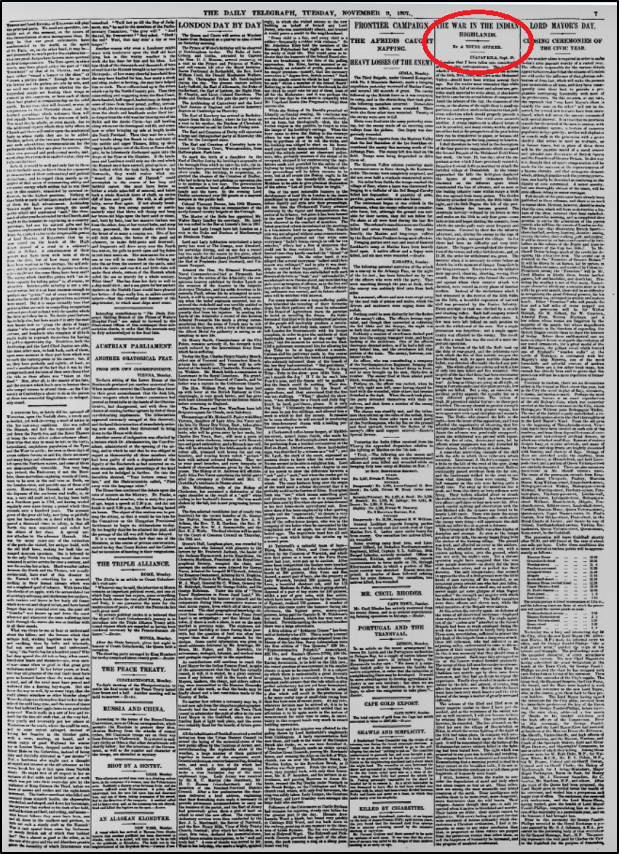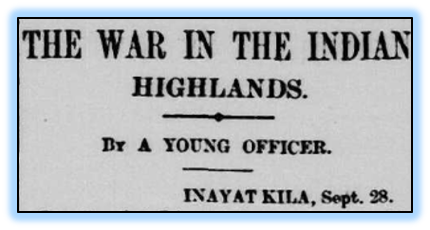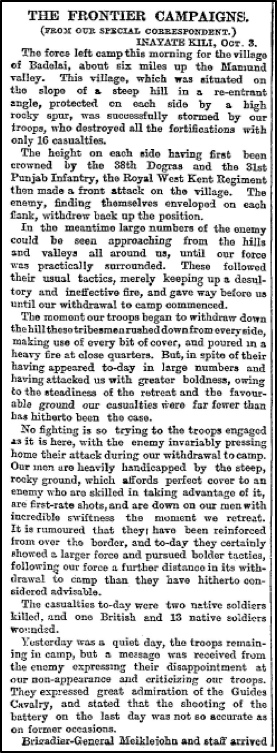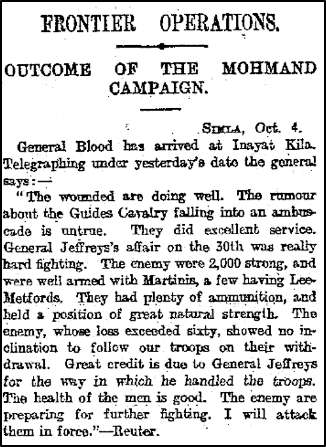Posted on December 14, 2015
By: Daniel Pullin, Publishing Assistant, Gale, a part of Cengage Learning
When the name ‘Winston Churchill’ is mentioned, images of a heroic war leader with cigar in mouth and face set in steely determination are usually the first to come to mind. His wartime speeches became iconic in symbolising gung-ho British determination to battle on through endless bloodshed, helping steer Britain through the turmoil of a cataclysmic conflict. Yet, with perhaps less well-known flair, the former Prime Minister proved equally adept on paper. This is evident in his first published material: a series of war letters commissioned for British newspaper The Daily Telegraph.
Between October and December 1897, Churchill wrote and published the eleven letters while accompanying the Malakand Field Force in India. With Gale’s The Telegraph Historical Archive, 1855-2000 now available, these letters are fully-searchable in digital format for the first time. This gave me the perfect opportunity to explore their contents.

Taking the articles as a whole, the prominence of their location on each page is striking. Written during a time when competition for column inches was high (The Telegraph was typically made up of twelve to sixteen pages in 1897, with up to seven columns of densely-packed news), Churchill’s articles always featured along the top row of news items. Although the pieces were not directly attributed to the then-unknown Churchill – instead attributed to ‘A Young Officer’ – they were given a prominent heading. This portrays the impression that the Telegraph’s editor, Edwin Arnold, placed considerable faith in the reporting of an inexperienced officer. A strong advocate of British imperialism, Arnold was described as a ‘fierce lover of India’.[2] Perhaps this helps to explain his willingness to devote precious space in his newspaper to a young writer (paying him a respectable five pounds per piece in the process)[3].

However, on reading the accounts themselves, it seems somewhat unjustified to attribute their success to the subject matter alone. The articles’ informal, talkative style gave them a readability hitherto unseen in the more sedate national press.[4] This is apparent from the very first line of the ninth letter of the series, published on 9 November 1897, in which Churchill described a British attack and subsequent retreat from the Indian village of Domodoloh. An almost apologetic tone was adopted: ‘I realise that I have fallen into considerable arrears in this correspondence’, he began, before candidly admitting that ‘this letter… should have been written several days ago’.[5] Reporting on a war full of ‘incident and adventure’ meant a lack of time in which to translate the action into articles.
Nevertheless, Churchill maintained a close rapport with the reader, referring to himself as ‘I’, and frequently addressing the reader directly. Take, for example, the line ‘remembering that a morning journal is read to a large extent at the breakfast table, I do not intend to describe the condition in which these poor fragments of humanity were found’.[6] This empathetic stance gave the reports a humanising element, helping to set The Telegraph apart from its national daily rivals – as well as marking the advent of what is now seen as the ‘new journalism’ at the turn of the century. The articles’ style was firmly in keeping with the values of The Telegraph; from its inception, the newspaper sought to set itself apart from its competitors by dedicating itself to lively copy. Owner Joseph Moses Levy once claimed that a dull paragraph was ‘enough to sink a ship’.[7] It is no wonder, then, that Churchill was keen to avoid becoming ‘tedious’ by relating the intimate details of every battle.

More broadly, we can explore this stylistic contrast by comparing The Telegraph’s reports from India with those from other leading UK national dailies, namely The Times and The Daily Mail. Taking first The Times’s report entitled ‘The Frontier Campaigns’, written by a special correspondent from Inayat Kila (the same camp as Churchill), there is none of the more intimate engagement with the reader which typified The Telegraph’s approach. Instead, there is a dedication to reporting all of the facts; who did what, when, and where it happened. Thus it states ‘the casualties today were two native soldiers killed, and one British and 13 native soldiers wounded’, before detailing which regiments were due to add back-up in the ensuing days.[8] There was evidently little concern that the newspaper might risk alienating its readers by simply relaying the facts; after all, this was what newspapers had always done.

All the more striking for its contrast is a report published in The Daily Mail on the same date as the Times piece. Coming to just 146 words – The Times’s and Churchill’s each totalled over 1,000 – the article simply outlined British Army commander General Blood’s statement on arrival at Inayat Kila. The piece was so brief that it could in fact have been written in bullet points, with sentences like ‘the health of the men is good’.[9] Such a short snippet would have given readers only the barest facts of the campaign, clearly reflecting the different editorial priorities of The Daily Mail. As the ‘busy man’s’ newspaper, it was keen to ensure that it could deliver the news in a simple, readable format.

Yet, while this may not have been particularly riveting to readers at the time, the article has a place in research today when used alongside the other two newspaper reports. Taken together, we have the personal reflections and intimacy of Churchill’s accounts for The Telegraph, the detailed facts of The Times, and the basic overview provided by The Daily Mail. We can, therefore, glean a rounded interpretation of events in India from these three sources, showing the importance of corroborative research. With all three newspapers available digitally in both standalone and cross-searchable format through Gale Artemis: Primary Sources, the opportunity to put this into practice is there for all.
Interested in getting a look at The Telegraph Historical Archive, 1855-2000? Pre-register to be one of the first to see a trial when this collection releases in March!
[1] ‘On the Indian Frontier’, The Daily Telegraph, 6 October 1897; pg. 7
[2] http://www.phx-ult-lodge.org/light_of_asia.htm
[3] Fully-trained journalists typically received pay of between sic and twenty pounds per week. L. Brake & M. Demoor (eds.), Dictionary of Nineteenth-Century Journalism (Gent, 2009), p. 325
[4] D. Griffiths, Fleet Street: Five Hundred Years of the Press (London, 2006), p. 97
[5] ‘The War in the Indian Highlands’, The Daily Telegraph, 9 November 1897
[6] ‘The War in the Indian Highlands’, The Daily Telegraph, 9 November 1897
[7] D. Griffiths, Fleet Street: Five Hundred Years of the Press (London, 2006), p. 97
[8] ‘The Frontier Campaigns’, The Times, 5 October 1897; pg. 3
[9] ‘Outcome of the Mohmand Campaign’, The Daily Mail, 5 October 1897; pg. 5nike roshe run black white hyper punch

